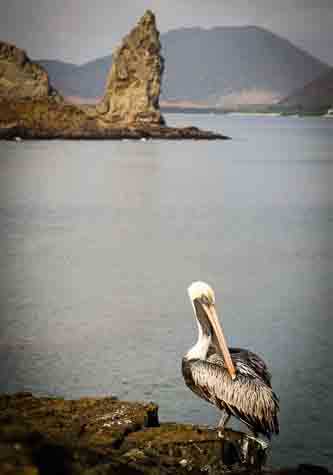Early this morning, we awoke to the National Geographic Endeavour gently rocking against its anchor in the calm waters of Sullivan Bay, on the eastern shores of James Island, as the sky behind the islet of Bartholomew slowly turned orange, marking the beginning of yet another amazing day to explore the Galapagos Archipelago.
As the sun started to break through clouds low on the eastern horizon, we made our way to shore for an early morning hike up to the summit of Bartholomew Islet. We were not the only “early birds” in the bay, as a few blue-footed boobies and pelicans flew overhead, searching for prey in the shallow waters. The majestic view of Pinnacle Rock, the two adjacent pristine beaches on each side of the islet and nearby James Island were an exceptional reward for waiting up early. We all made sure to photograph this iconic scene before heading back back to the ship for a well-deserved breakfast.
After lunch, we returned to the shore for water activities. All young explorers made sure to take advantage of the opportunity for a swim from the golden sand beach next to the Pinnacle Rock, before departing for a snorkeling session. We jumped into the deep waters of a narrow channel that separates the islet from a massive black lava field on the main island, produced by an eruption that happened only a few years after Charles Darwin’s 1835 visit to the archipelago.
During our two snorkeling sessions of the day at Bartholomew, and later on in the day at the Chinese Hat Islet, there were plenty of opportunities to spot resting white-tipped reef sharks in the shallows, spotted eagle rays and sting rays. As is so characteristic for the warmer months here in Galapagos, tropical fish take advantage of the warmer conditions to breed, with deep purple sergeant major males furiously chasing away other fish while protecting the small crevices where they tend to their eggs. Myriads of little baby fish seek the protection of the shallow rocky shore. Meanwhile, larger predatory fish were observed either making their rounds or letting themselves be cleaned by barberfish and butterflyfish. Even the few penguins, those who are not molting in preparation for the approaching cooler months, made repeated appearances to show off their agility in the water.
As the flat light of the late afternoon announced the approaching end of yet another spectacular day, we made it onto our Zodiacs to pay a last visit to the penguins, which patiently roost on the rocky shore waiting for their new insolating plumage to come through. It will only be a few more days before they once again can fly through the water with their usual grace.
As we make our way back to the National Geographic Endeavour, my mind is already in Genovesa Island and its million bird colony, which is where our floating home will be bringing us tomorrow.







